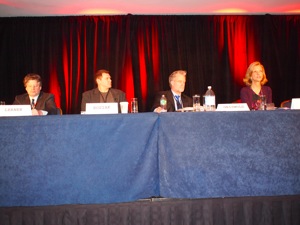 Ted Hill, President, THA Consulting; Timothy Griswold, Vice President Sales and E-Retail Sales, Springer; Adam Lerner, President, Lerner Publishing Co.; Deborah Forte, President, Scholastic Media; Mike Rosiak, Lead Content Architect, Wolters Kluwer Health
Ted Hill, President, THA Consulting; Timothy Griswold, Vice President Sales and E-Retail Sales, Springer; Adam Lerner, President, Lerner Publishing Co.; Deborah Forte, President, Scholastic Media; Mike Rosiak, Lead Content Architect, Wolters Kluwer Health
Hill, moderator: cross platform publishing is hard for many people in the industry to grasp, especially since there are so many different pieces.
Forte: from the non-print part of Scholastic and focus on content that is based on books. Content is the driver, like any new delivery system one has to have content that people want or the platform, device, etc. won’t thrive. Pull vs. push mode, customers have many choices on digital platform, the customer is in charge and the onus is on us t meet their needs and access and ease of use will drive customer decisions. Emergence of new paradigms, media vs . publishing paradigm, new parameters introduced, windowing, global emphasis, cross platform approach; brands matter, individual titles are getting harder to market, cross platform exposure provides the opportunity to build and sustain brands. Challenges to go cross platform: understanding the digital ecosystems and the parameters around content, technology and marketing. Most publishers don’t understand this yet. Articulating a strong value proposition, how do we protect the values and pricing of content when the content seems transient in the digital world. Defining clear benchmarks for success is a real challenge. It’s hard to determine what format to use. Important to develop content as marketing – sampling for example. Found great success in choosing from backlist special books that lend themselves to digital. Introducing new content digitally on a continuous basis helps to maintain the brand and actually helps sell the print books. Is not one or the other, print and digital can complement each other in proper strategy. Need an in-house understanding of the technology so that you will make the right decisions about what to develop and what to stay away from.
Lerner: people underestimate the amount of change that publishers are going through. Primarily a school and library publisher. Started with ebooks in 2007 and had to hire a director with ed tech experience to evaluate the market. Produced simple web ready ebook files and leveraged internal resources for production and metadata file distribution. Are a small company and trying to remain a content company. Unless are a large company you will not succeed in being both a content and technology company. Have to partner outside to develop a technology platform. Used Impelsys for this. Went through 3 phases to develop digital product: started with existing print and retrofit them into digital media, had to go outside for a partner for this; with requirements and quality set, did a second set of products with offshore developers; and in phase 3 developed a production engine that incorporates digital content into normal workflow. Phased approach has led to success, so far. Started with an outside partner and gradually incorporate what they learned into internal workflows.
Rosiak: from a medical publisher who makes content available in hardback and in all sorts of media – from web to pda. Underneath all their cross platform publishing is xml. Lessons learned in cross platform publishing: expect false starts, looses of faith and peer rejection; be careful not to replicate a print-focued process; there’s a tricky balance between making xml editing user friendly and over-engineering the system; an on-demand proofing mechanism is a key; there a place for pristine xml and a place for pragmatic xml; channel partners may not like your xml.
Griswold: publishes about 2,000 journals and 6.500 books a year. Need to have a strategy and and to look at data quality and consistency. Are platform neutral between Kindle, iPad, etc. Have made large strides to move to print on demand and will be looking into custom publishing. Needed to start developing a strategy to deliver electronic content to the individual. Testing and quality control are essential, especially if content is complex. Currently providing full text delivery. Looking at new models: rent content with opportunity; deliver content in chapters with option to buy, publish journals in entire content and on an article basis. Author contracts may need to be revised when looking at new models of deliver, for example how do you calculate royalties in a rental situation. Need to be extremely flexible because market is changing day by day. One of hardest things is bringing everybody into the room to develop a comprehensive strategy. Pilot programs are very useful in convincing people to get on board with digital. May not do the technology but have to have the resources in-house to understand the technology so that you have an in-house perspective on what can and can’t be done.

































